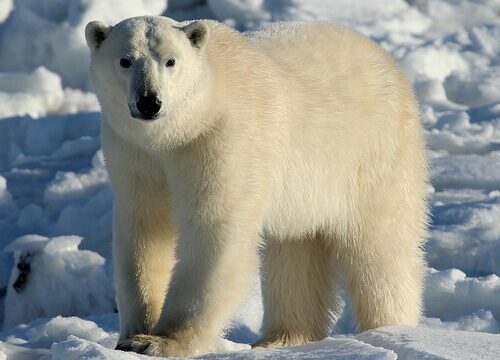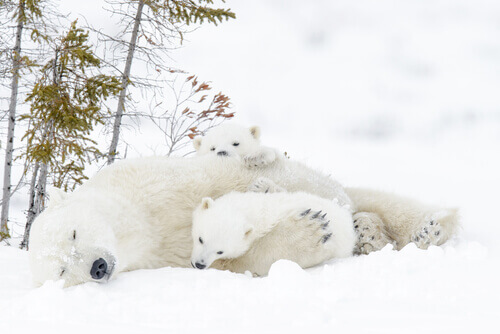Find Out All About the Life of a Polar Bear

The life of a polar bear is very interesting; they’re one of the largest carnivorous mammals in the world. They live only in very cold places near the Arctic region; the largest populations are found in Canada, Alaska, Greenland and Siberia.
Zoologists believe that this species descended from the brown bear, and that its fur changed color to adapt to its habitat. So, what’s life like for a polar bear?
Polar bear size
Polar bears are huge; an adult male can be up to ten feet tall and weigh up to 1500 pounds. Their size means they walk rather awkwardly; they need a use a lot of energy to move all that weight around. However, they have highly developed legs and can withstand long walks.
Adaptation to the cold
The polar bear’s body has undergone various mutations in order to adapt to the extreme conditions it lives in. Its ears and tail are small in order to conserve body heat in very low temperatures.
Their skin has a thick layer of fat which helps them to regulate their temperature. Polar bear fur is translucent and is made up of thousands of hollow hairs that are filled with air; this allows them to maintain a suitable temperature. Their fur is actually black, which makes them better able to catch the sun’s rays.

Swimming ability
Polar bears don’t spend their whole lives in the snow. They’re also excellent swimmers and spend many hours submerged in icy waters; they’re capable of swimming long distances and for a long time. In fact, they can make trips in the water of up to 10 days.
They often take their cubs on these water trips, and the cubs are able to keep up with their mothers in the water.
The life of a polar bear: feeding
The polar bear is definitely an animal that has very special characteristics. For example, it doesn’t drink water, as in the places where it lives the water is salty. Instead, it ingests the blood of its prey to hydrate itself.
A large part of the polar bear’s life is dedicated to hunting. They feed on seals and sometimes also on reindeer or other land animals; in fact they can eat up to 65 pounds of meat in a day.
To hunt aquatic animals, the polar bear makes holes in the ice and waits for an animal to come up for air to catch it. Some scientists have even described cases of cannibalism among males due to food shortage: they feed on other weak or young polar bears.
Hibernation
Male polar bears don’t hibernate. They have the ability to slow down their heart rate and continue their normal life even in extremely cold and dark conditions.
However, pregnant females do hibernate, and their cubs are born during this hibernation period. The cubs remain for several months in the hibernation den, which the mothers dig out of the ice, before emerging into the outside world.
Reproduction
Polar bears reach sexual maturity at three to four years of age. Mating occurs between April and May; females and males live together and gradually become friendly.

The female has the amazing ability to store her eggs so that they only begin to develop from September onwards. In the meantime, she goes about storing as much fat as possible.
When they’re born, the hatchlings are blind and have no teeth, so for the first five months they can’t fend for themselves. They feed only on their mother’s milk, who loses a lot of weight during this period.
The first months of life are very difficult for a polar bear. Threats and risks are all around them, and many die before they’re a year old.
The polar bear and global warming
The world’s population of polar bears is currently threatened by global warming. The melting of large chunks of ice is forcing them to retreat further inland, and this completely changes their reproductive cycle, resulting in far fewer births.
This phenomenon also affects the availability of prey. Seals, their main source of food, have to constantly move around in order to find their own food. This makes hunting increasingly difficult for polar bears.
This text is provided for informational purposes only and does not replace consultation with a professional. If in doubt, consult your specialist.